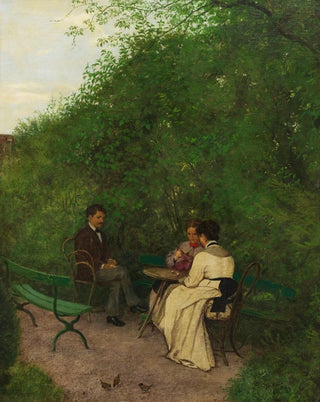Art print | In the Garden - Hans Thoma


View from behind

Frame (optional)
"Dans le jardin" by Hans Thoma is an artwork that invites contemplation and escape. Painted at the end of the 19th century, it depicts a lush garden where nature flourishes in all its splendor. The artist, known for his ability to capture the beauty of the natural world, transports us to a space where time seems suspended. The vibrant colors and harmonious shapes evoke an atmosphere of serenity and joy, where each element of the garden appears to tell a story. This piece, both simple and rich in detail, reminds us of the importance of nature in our daily lives and how it can nourish our spirit.
Style and uniqueness of the work
Hans Thoma's style is characterized by poetic realism and meticulous attention to detail. In "Dans le jardin," he manages to harmonize a faithful representation of flora with an almost dreamlike approach. The play of light and shadow, along with delicate colors, creates an enchanting atmosphere. Thoma uses painting techniques that allow him to render the texture of leaves, the softness of petals, and the depth of shadows, thus bringing each element of the painting to life. The composition is carefully balanced, with an arrangement that guides the viewer's eye through the garden, inviting visual exploration. This work stands out not only for its beauty but also for the way it evokes feelings of peace and harmony.
The artist and his influence
Hans Thoma, born in 1839, is an emblematic figure of 19th-century German art. His artistic journey is marked by a deep connection with nature and a quest for spirituality through art. Influenced by the Romantic movement, he seeks to express profound emotions and reflections on the world around him. Thoma was also a pioneer in using color to create evocative atmospheres, an aspect that is fully present in "Dans le jardin." His work had a significant impact on his contemporaries and continues to inspire many artists today. By exploring universal themes such as beauty and nature, he paved the way for a new way of perceiving the landscape, making

Matte finish

View from behind

Frame (optional)
"Dans le jardin" by Hans Thoma is an artwork that invites contemplation and escape. Painted at the end of the 19th century, it depicts a lush garden where nature flourishes in all its splendor. The artist, known for his ability to capture the beauty of the natural world, transports us to a space where time seems suspended. The vibrant colors and harmonious shapes evoke an atmosphere of serenity and joy, where each element of the garden appears to tell a story. This piece, both simple and rich in detail, reminds us of the importance of nature in our daily lives and how it can nourish our spirit.
Style and uniqueness of the work
Hans Thoma's style is characterized by poetic realism and meticulous attention to detail. In "Dans le jardin," he manages to harmonize a faithful representation of flora with an almost dreamlike approach. The play of light and shadow, along with delicate colors, creates an enchanting atmosphere. Thoma uses painting techniques that allow him to render the texture of leaves, the softness of petals, and the depth of shadows, thus bringing each element of the painting to life. The composition is carefully balanced, with an arrangement that guides the viewer's eye through the garden, inviting visual exploration. This work stands out not only for its beauty but also for the way it evokes feelings of peace and harmony.
The artist and his influence
Hans Thoma, born in 1839, is an emblematic figure of 19th-century German art. His artistic journey is marked by a deep connection with nature and a quest for spirituality through art. Influenced by the Romantic movement, he seeks to express profound emotions and reflections on the world around him. Thoma was also a pioneer in using color to create evocative atmospheres, an aspect that is fully present in "Dans le jardin." His work had a significant impact on his contemporaries and continues to inspire many artists today. By exploring universal themes such as beauty and nature, he paved the way for a new way of perceiving the landscape, making






